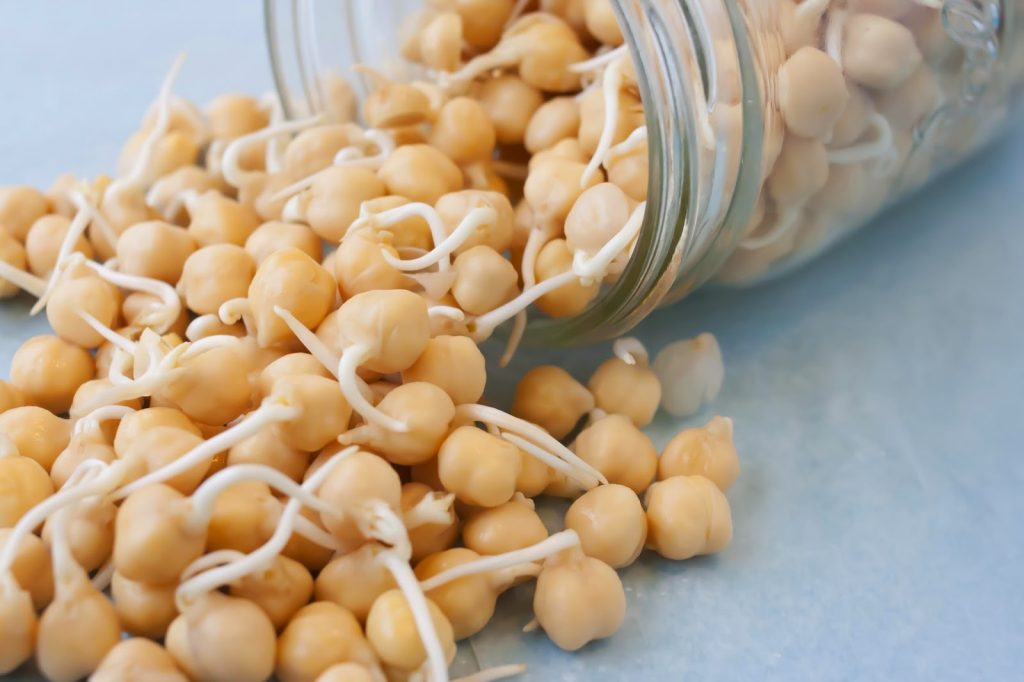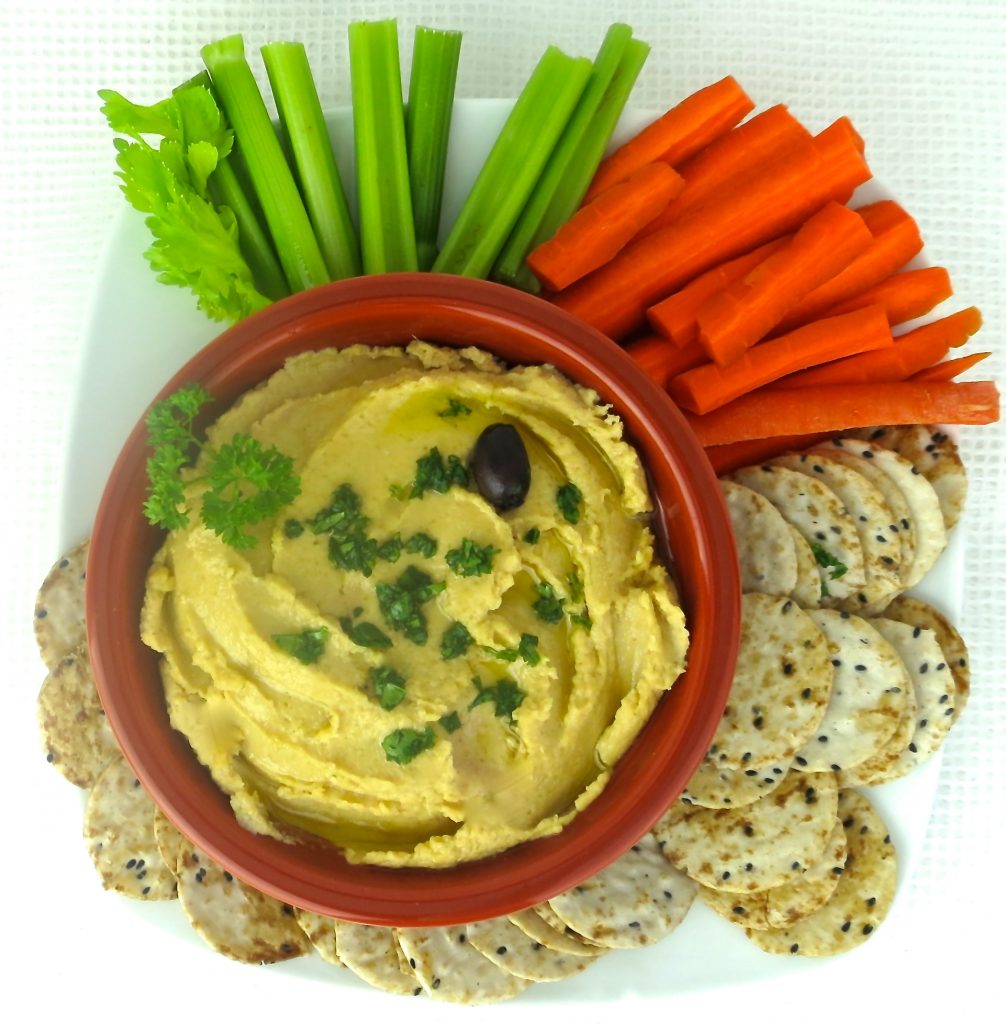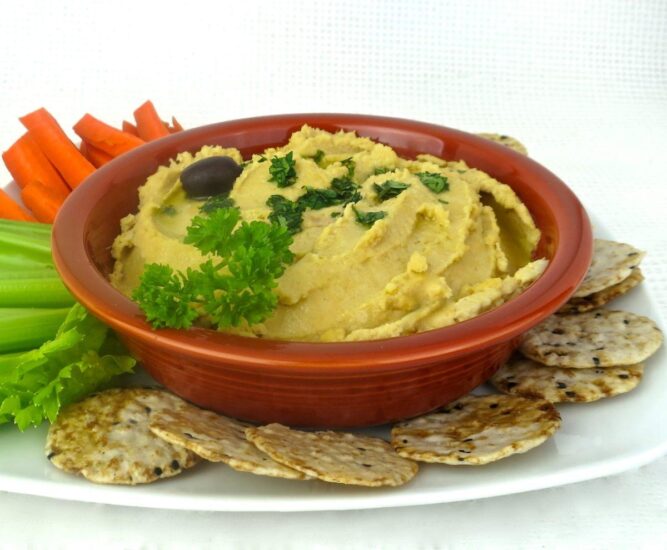This homemade hummus is quick to make, tasty, super-nourishing, and EASY TO DIGEST. Hummus is supposed to be a healthy snack, a staple of the Mediterranean diet. Every Lebanese grandmother knows how to make old-fashioned hummus with sprouted chick peas. Traditional soaking and sprouting makes beans sweet, digestible, healthy, and quick to cook. Otherwise, beans are simply indigestible, if you know what I mean!
Soaking and sprouting dissolves the indigestible natural coatings on beans. Unfortunately, modern industrial methods skip this essential step. The sad results are intestinal gas, indigestion, and poor nutrient absorption. All beans have natural phytate, a non-digestible coating, which blocks absorption of iron, zinc, calcium and other important minerals. Phytates are a leading cause of bad digestion, anemia, and immune dysfunction worldwide. Soaking and sprouting resolves that problem. (Read more about phytates, lectins, saponins.)
This hummus is special, because it is also free of nightshades. Approximately 35% of humans (Caucasians in particular) have digestive reactions to nightshade vegetables: tomatoes, peppers, white potatoes, and eggplant. If that is you, avoid store-bought hummus made with tomatoes, paprika, peppers, or cayenne. Authentic Lebanese hummus doesn’t contain any of those extra things. Check out my article Beware of Nightshades about risks of leaky-gut and auto-immune disease. The good news is, THIS homemade hummus is tasty and healthy for just about everybody on the planet. It is delicious, protein-rich, high in minerals, easily digestible, quick to cook, free of indigestibles and nightshades. Store in the refrigerator for about 3 days, or freeze in a BPA-free plastic container for up to 3 months. Serve at room temperature. Makes 2 cups yummy hummus!
 Soaking 8-12 hours softens and removes many of the beans’ indigestible coatings. Sprouting 2-3 days removes most of the coatings, makes beans softer, alive with life energy, lower in carbs, and quicker to cook. After sprouting, you’ll see the white root shoot on the chick peas.
Soaking 8-12 hours softens and removes many of the beans’ indigestible coatings. Sprouting 2-3 days removes most of the coatings, makes beans softer, alive with life energy, lower in carbs, and quicker to cook. After sprouting, you’ll see the white root shoot on the chick peas.
 Serve at room temperature with olive oil, parsley, maybe crackers and raw veggies.
Serve at room temperature with olive oil, parsley, maybe crackers and raw veggies.
Ingredients
- 1 cup organic dry chick peas (garbanzo beans)
- filtered water to cover, and no salt
- 4 cloves garlic
- 1 1/2 teaspoons unprocessed salt
- 1/3 cup toasted sesame tahini
- 6 tablespoons lemon juice
- 1 teaspoon ground cumin (optional)
- 1-2 tablespoons olive oil or water from boiling, if needed to blend
- chopped parsley to garnish
Instructions
- Rinse and soak chickpeas. Place in a quart-size sprouting jar. Add 2-3 cups water, filling the jar 3/4 full, cover with a sprouting screen, cloth, or mesh lid. Soak 8 hours or overnight. If you want to cook the beans now, skip to Step 3.
- To sprout, drain and rinse the beans. Invert jar into a bowl at an angle so the beans will drain and air can circulate. Rinse and drain each day for 1-3 days.
- Rinse again and put them in a pot filed with filtered water to cover. Boil until tender, 1-2 hours. A pressure cooker works even faster.
- Turn on the food processor with the "S" blade, and drop the garlic down the feed tube to mince. A wonderful trick! Add the rest of the ingredients to the food processor and process for a few minutes until the hummus is as smooth as possible. Taste for seasoning. Serve at room temperature drizzled with olive oil and garnish with parsley.





1 Reply to "Sprouted Hummus, Original Lebanese Recipe"
Cindy Vellinga January 28, 2022 (8:34 am)
Sounds yummy